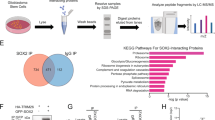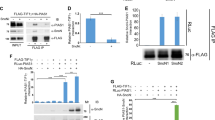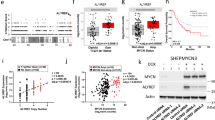Abstract
The Tr2 orphan nuclear receptor can be SUMOylated, resulting in the replacement of coregulators recruited to the regulatory region of its endogenous target gene, Oct4. UnSUMOylated Tr2 activates Oct4, enhancing embryonal carcinoma-cell proliferation, and is localized to the promyelocytic leukemia (Pml) nuclear bodies. When its abundance is elevated, Tr2 is SUMOylated at Lys238 and seems to be released from the nuclear bodies to act as a repressor. SUMOylation of Tr2 induces an exchange of its coregulators: corepressor Rip140 replaces coactivator Pcaf, which switches Tr2 from an activator to a repressor. This involves dynamic partitioning of Tr2 into Pml-containing and Pml-free pools. These results support a model where SUMOylation-dependent partitioning and differential coregulator recruitment contribute to the maintenance of a homeostatic supply of activating, as opposed to repressive, Tr2, thus fine-tuning Oct4 expression and regulating stem-cell proliferation.
This is a preview of subscription content, access via your institution
Access options
Subscribe to this journal
Receive 12 print issues and online access
$209.00 per year
only $17.42 per issue
Buy this article
- Purchase on SpringerLink
- Instant access to full article PDF
Prices may be subject to local taxes which are calculated during checkout






Similar content being viewed by others
Accession codes
References
Wei, L.-N. & Hsu, Y.-C. Identification of a new gene expressed specifically in early mouse embryos. Dev. Growth Differ. 36, 187 (1994).
Lee, C.-H., Copeland, N.G., Gilbert, D.J., Jenkins, N.A. & Wei, L.-N. Genomic structure, promoter identification and chromosomal mapping of a mouse nuclear orphan receptor expressed in embryos and adult testes. Genomics 30, 46–52 (1995).
Lee, C.-H., Chang, L. & Wei, L.-N. Distinct expression patterns and biological activities of two isoforms of the mouse orphan receptor TR2. J. Endocrinol. 152, 245–255 (1997).
Lee, C.-H. & Wei, L.-N. Characterization of an inverted repeat with a zero spacer (IR0)-type retinoic acid response element from the mouse nuclear orphan receptor TR2–11 gene. Biochemistry 38, 8820–8825 (1999).
Chinpaisal, C., Lee, C.-H. & Wei, L.-N. Mechanisms of the mouse orphan nuclear receptor TR2–11 mediated gene suppression. J. Biol. Chem. 273, 18077–18085 (1998).
Shyr, C.R., Collins, L.L., Mu, X.M., Platt, K.A. & Chang, C. Spermatogenesis and testis development are normal in mice lacking testicular orphan nuclear receptor 2. Mol. Cell. Biol. 22, 4661–4666 (2002).
Lee, C.-H., Chinpaisal, C. & Wei, L.-N. Cloning and characterization of mouse RIP140, a corepressor for nuclear orphan receptor TR2. Mol. Cell. Biol. 18, 6745–6755 (1998).
Lin, T.M., Young, W.J. & Chang, C. Multiple functions of the TR2–11 orphan receptor in modulating activation of two key cis-acting elements involved in the retinoic acid signal transduction system. J. Biol. Chem. 270, 30121–30128 (1995).
Wei, L.-N., Hu, X. & Chinpaisal, C. Constitutive activation of retinoic acid receptor β2 promoter by orphan nuclear receptor TR2. J. Biol. Chem. 275, 11907–11914 (2000).
Khan, S.A., Park, S.W., Huq, M.D.M. & Wei, L.-N. Protein kinase C-mediated phosphorylation of orphan nuclear receptor TR2: effects on receptor stability and activity. Proteomics 5, 3885–3894 (2005).
Khan, S.A., Park, S.W., Huq, M.D.M. & Wei, L.-N. Ligand-independent orphan receptor TR2 activation by phosphorylation at the DNA binding domain. Proteomics 6, 123–130 (2006).
Okazawa, H. et al. The Oct3 gene, a gene for an embryonic transcription factor, is controlled by a retinoic acid repressible enhancer. EMBO J. 10, 2997–3005 (1991).
Pikarsky, E., Sharia, H., Ben-Shushan, E. & Bergman, Y. Retinoic acid represses Oct-3/4 gene expression through several retinoic acid-responsive elements located in the promoter-enhancer region. Mol. Cell. Biol. 14, 1026–1038 (1994).
Nichols, J. et al. Formation of pluripotent stem cells in the mammalian embryo depends on the POU transcription factor Oct4. Cell 95, 379–391 (1998).
Niwa, H., Miyazaki, J.-I. & Smith, A.G. Quantitative expression of Oct-3/4 defines differentiation, dedifferentiation or self-renewal of WS cells. Nat. Genet. 24, 372–376 (2000).
Chambers, I. & Smith, A. Self-renewal of teratocarcinoma and embryonic stem cells. Oncogene 23, 7150–7160 (2004).
Ovitt, C.E. & Scholer, H.R. The molecular biology of Oct4 in the early mouse embryo. Mol. Hum. Reprod. 4, 1021–1031 (1998).
Marin, M., Karis, A., Visser, P., Grosveld, F. & Philipsen, S. Transcription factor Sp1 is essential for early embryonic development but dispensable for cell growth and differentiation. Cell 89, 619–628 (1997).
Barnea, E. & Bergman, Y. Synergy of SF1 and RAR in activation of Oct-3/4 promoter. J. Biol. Chem. 275, 6608–6619 (2000).
Gu, P. et al. Orphan nuclear receptor GCNF is required for the repression of pluripoptency genes during retinoic acid-induced embryonic stem cell differentiation. Mol. Cell. Biol. 25, 8507–8519 (2005a).
Gu, P. et al. Orphan nuclear receptor LRH-1 is required to maintain Oct4 expression at the epiblast stage of embryonic development. Mol. Cell. Biol. 25, 3492–3505 (2005b).
Schoorlemmer, J. et al. Characterization of a negative retinoic acid response element in the murine Oct4 promoter. Mol. Cell. Biol. 14, 1122–1136 (1994).
Anckar, J. et al. Inhibition of DNA binding by differential sumoylation of heat shock factors. Mol. Cell. Biol. 26, 955–964 (2006).
Lee, M.B. et al. The DEAD-box protein DP103 (Ddx20 or Gemin-3) represses orphan nuclear receptor activity via SUMO modification. Mol. Cell. Biol. 25, 1879–1890 (2005).
Pascual, G. et al. A SUMOylation-dependent pathway mediates transrepression of inflammatory response genes by PPAR-γ. Nature 437, 759–763 (2005).
Yang, S.H. & Sharrocks, A.D. SUMO promotes HDAC-mediated transcriptional repression. Mol. Cell 13, 611–617 (2004).
Ross, S., Best, B., Zon, L. & Gill, G. SUMO-1 modification represses Sp3 transcriptional activation and modulates its subnuclear localization. Mol. Cell 10, 831–842 (2002).
Quimby, B.B., Yong-Gonzalez, V., Anan, T., Strunnikov, A.V. & Dasso, M. The promyelocytic leukemia protein stimulates SUMO conjugation in yeast. Oncogene 25, 2999–3005 (2006).
Lee, C.-H., Chang, L. & Wei, L.-N. Molecular cloning and characterization of a mouse nuclear orphan receptor expressed in embryos and testes. Mol. Reprod. Dev. 44, 305–314 (1996).
Yang, M., Hsu, C.T., Ting, C.Y., Liu, L.F. & Hwang, J. Assembly of a polymeric chain of SUMO1 on human topoisomerase I in vitro. J. Biol. Chem. 281, 8264–8274 (2006).
Rodriguez, M.S., Dargemont, C. & Hay, R.T. SUMO-1 conjugation in vivo requires both a consensus modification motif and nuclear targeting. J. Biol. Chem. 276, 12654–12659 (2001).
Rochette-Egly, C. Dynamic combinatorial networks in nuclear receptor-mediated transcription. J. Biol. Chem. 280, 32565–32568 (2005).
Wu, R.C., Smith, C.L. & O'Malley, B.W. Transcriptional regulation by steroid receptor coactivator phosphorylation. Endocr. Rev. 26, 393–399 (2005).
Lonard, D.M. & O'Malley, B.W. Expanding functional diversity of the coactivators. Trends Biochem. Sci. 30, 126–132 (2005).
Gill, G. Something about SUMO inhibits transcription. Curr. Opin. Genet. Dev. 15, 536–541 (2005).
Johnson, E.S. Protein modification by SUMO. Annu. Rev. Biochem. 73, 355–382 (2004).
Ulrich, H.D. SUMO modification: wrestling with protein conformation. Curr. Biol. 15, R257–R259 (2005).
Hay, R.T. SUMO: a history of modification. Mol. Cell 18, 1–12 (2005).
Yang, H.M. et al. Characterization of putative cis-regulatory elements that control the transcriptional activity of the human Oct4 promoter. J. Cell. Biochem. 96, 821–830 (2005).
Spengler, M.L. & Brattain, M.G. Sumoylation inhibits cleavage of Sp1 N-terminal negative regulatory domain and inhibits Sp1-dependent transcription. J. Biol. Chem. 281, 5567–5574 (2006).
Sentis, S., Romancer, M.L., Bianchin, C., Rostan, M.C. & Corbo, L. Sumoylation of the estrogen receptor alpha hinge region regulates its transcriptional activity. Mol. Endocrinol. 19, 2671–2684 (2005).
Chalkiadaki, A. & Talianidis, I. SUMO-dependent compartmentalization in promyelocytic leukemia protein nuclear bodies prevents the access of LRH-1 to chromatin. Mol. Cell. Biol. 25, 5095–5105 (2005).
Gross, M., Yang, R., Top, I., Gasper, C. & Shuai, K. PIASy-mediated repression of the androgen receptor is independent of sumoylation. Oncogene 23, 3059–3066 (2004).
Chauchereau, A., Amazit, L., Quesne, M., Guiochon-Mantel, A. & Milgrom, E. Sumoylation of the progesterone receptor and of the steroid receptor coactivator SRC-1. J. Biol. Chem. 278, 12335–12343 (2003).
Tian, S., Poukka, H., Palvimo, J.J. & Jänne, O.A. Small ubiquitin-related modifier-1 (SUMO-1) modification of the glucocorticoid receptor. Biochem. J. 367, 907–911 (2002).
Dellaire, G. & Bazett-Jones, D.P. PML nuclear bodies: dynamic sensors of DNA damage and cellular stress. Bioessays 26, 963–977 (2005).
Bossis, G. & Melchior, F. Regulation of SUMOylation by reversible oxidation of SUMO conjugating enzymes. Mol. Cell 21, 349–357 (2006).
Park, S.W. et al. Thyroid hormone-induced juxtaposition of regulatory elements/factors and chromatin remodeling of Crabp1 dependent on MED1/TRAP220. Mol. Cell 19, 643–653 (2005).
Acknowledgements
This work was supported by US National Institutes of Health grants DK54733, DK60521, K02 DA13926 and DA11190 to L.-N.W. We also thank C.H. Lee and C. Chainpaisal for yeast screening and N.P. Tsai, F.C. Walosin and S.D. Persaud for technical support.
Author information
Authors and Affiliations
Contributions
S.W.P. initiated the study of differential regulation of Oct4 by Tr2, designed and performed experiments and analyzed data. X.H. initiated and performed experiments on SUMOylation of Tr2 and constructed plasmids. P.G. conducted immunoprecipitations, mammalian two-hybrid assays and RNA interference experiments. Y.-P.L. conducted RT-PCR and ChIP assays. S.G.H. conducted immunofluorescence microscopy. L.-N.W. supervised the entire project and provided all the financial support.
Corresponding author
Ethics declarations
Competing interests
The authors declare no competing financial interests.
Rights and permissions
About this article
Cite this article
Park, S., Hu, X., Gupta, P. et al. SUMOylation of Tr2 orphan receptor involves Pml and fine-tunes Oct4 expression in stem cells. Nat Struct Mol Biol 14, 68–75 (2007). https://doi.org/10.1038/nsmb1185
Received:
Accepted:
Published:
Issue Date:
DOI: https://doi.org/10.1038/nsmb1185
This article is cited by
-
Sumoylation of histone deacetylase 1 regulates MyoD signaling during myogenesis
Experimental & Molecular Medicine (2018)
-
Role of Oct4 in the early embryo development
Cell Regeneration (2014)
-
Interferon controls SUMO availability via the Lin28 and let-7 axis to impede virus replication
Nature Communications (2014)
-
PML-mediated signaling and its role in cancer stem cells
Oncogene (2014)
-
NuRD–ZNF827 recruitment to telomeres creates a molecular scaffold for homologous recombination
Nature Structural & Molecular Biology (2014)



